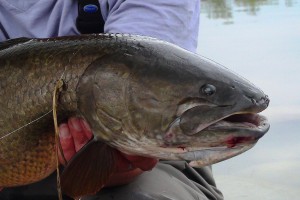The bowfin (amia calva) is notorious for generating troublesome questions. Is it a destructive menace to recreational fisheries or an important keystone predator for healthy aquatic communities?
 Is it closer cousin to the primitive gars or to the modern teleost fishes? And is it kosher?
Is it closer cousin to the primitive gars or to the modern teleost fishes? And is it kosher?
The first two questions have been debated and discussed by fish biologists for decades. The last question surfaced recently and presented an unusual opportunity for collaboration between Jewish clerics and several NANFA members.
In November 2003, Rabbi Chaim Goldberg of the Orthodox Union in New York City contacted Mark Binkley.
Rabbi Goldberg needed to determine whether bowfin met the criteria established for a fish to be considered kosher: i.e., easy removal of the scales without tearing the underlying skin. Somehow, the fish had been dually listed as “kosher” and “not kosher,” and the Orthodox Union, the world’s largest certifying agency of kosher foods, needed to resolve the question. The rabbi, seeing bowfin on Jonah’s Aquarium website, contacted Mark.
Mark explained that bowfin scales are intermediate in form to those of gar and modern fishes, and seem well-attached to the skin, but admitted that he had never tried to de-scale one. He referred Rabbi Goldberg to Ray Wolff and myself. Ray contacted the rabbi, offering to try catching one as he had no surplus specimens at hand. I have two live bowfin in a display tank in the lobby of our laboratory but they are now a featured stop on our educational tours.
I wrote to Rabbi Goldberg and sent him background information on bowfin (including articles from American Currents). We agreed that the published descriptions of bowfin scales are indeed ambiguous. The scales are described as “cycloid,” lacking an enamel covering (ganoin). This suggests a “kosher” designation (like common carp). However, bowfin were historically classified along with other “ganoid” species suggesting that it is not “kosher” (like sturgeon, paddlefish, and gar). A monograph on bowfins notes that the scales of our single living species are unusual (Grande and Bemis, 1998). They are thin, sub-rectangular to oval, overlap each other for nearly two-thirds of their area, and develop growth rings (annuli). Thus, they are very unlike the scales of gar. They are unlike the scales of most teleosts, however, because they have a series of longitudinal ridges and lack radii.
Clearly, a specimen of bowfin was required to settle the question. My co-worker Steven George, famous for archiving all usable specimens and by-catch, checked his freezers. He had a 5-lb specimen that would serve the Union’s needs. On 09 Dec, Steven packed up the fish and sent it via overnight delivery to New York City where it was examined by Rabbi Goldberg and his colleagues. After examination, Rabbi Goldberg wrote: “The question is that, though the scales come out cleanly (and we do not believe freezing changed this as they come out very cleanly), there is something underneath the scales which looks like it might be attaching one scale to the ones under it. That might be tearing when the scale is removed. We are not clear yet whether this is an issue or not.” A photograph provided by the rabbi shows how the scales overlap and appear to be either embedded in the skin, or connected to each other by a skin-like material. Rabbi Goldberg also reports that they conferred with another kosher fish expert on this matter. After consulting some legal texts, they together concluded that the damage caused by removing the scales was not of the severity to preclude the bowfin from being kosher, but that they could not confirm this officially without testing a specimen that was not previously frozen.
The question of the bowfin’s “kosher” status is not an esoteric one. Recent popularization of “rough-fishing” (including bowfin) its attendant cuisine (Buffler and Dickson, 1990) and attempts at bowfin aquaculture (Huner, 1994) make it increasingly likely that bowfin will be a menu item for adventurous cooks and gourmands. Whether it can be served as “kosher” table fare, however, we hope will be resolved soon.
LITERATURE CITED
- Bufler, R. and T. Dickson. 1990. Fishing for buffalo. Minneapolis: Culpepper Press.
- Grande, L. and W.E. Bemis. 1998. A comprehensive phylogenetic study of amiid fishes (Amiidae) based on comparative skeletal anatomy – An empirical search for interconnected patterns of natural history.
- Society of Vertebrate Palaeontology Memoir 4: I-x, 1-690 + 2 foldouts.
- Huner, J.V. 1994. Bowfin culture at the University of Southwestern Louisiana. Aquaculture Magazine 20 (5) [Sep-Oct]: 28-37.
- Reprinted with permission from “American Currents”, Publication of The North American Native Fishes Association, May 2004 issue.

